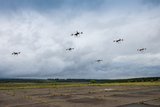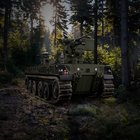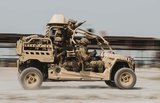Northrop Grumman Awarded US Army Contract to Relocate Hunter Training and Test Facilities
The US Army Unmanned Aircraft System (UAS) office has awarded Northrop Grumman Corporation a $6.2 million contract to move the Army's Hunter UAS training and engineering test facilities from Cochise College Flight Line, Douglas, Ariz., to the new Rapid Integration and Acceptance Center (RIAC), Michael Army Airfield, Dugway Proving Grounds, Utah.
"We're happy to work shoulder to shoulder with the Army to make this move happen," said Karl Purdy, Northrop Grumman Technical Services program manager. "The move allows the Army to achieve synergy by having UAS assets in one location to improve interoperability and efficiency of assets."
The MQ-5B Hunter, which is currently deployed in contingency operations, provides warfighters with state-of-the-art Reconnaissance, Surveillance, and Target Acquisition (RSTA), communications relay, signal intelligence, and weapons delivery. Hunter has nearly 82,000 flight hours, 56,000 of which are combat-related.
The RQ-5A Hunter was the Army's first fielded UAS. The MQ-5B is the next-generation Hunter, continuing a legacy of service to Army corps, division and brigade warfighters. Flying over the battlefield with its multi-mission optronic payload, the MQ-5B gathers RSTA information in real time and relays it via video link to commanders on the ground to dramatically reduce sensor-to-shooter time.
The MQ-5B Hunter is distinguished by its heavy fuel engines, its "wet" (fuel-carrying) extended center wing with weapons-capable hard points and a modern avionics suite.
The UAS uses the Army's One System ground control station and remote video terminal. It also carries a communications relay package to extend the radio range of warfighters. The MQ-5B features a robust, fixed-wing, twin tail-boom design with redundant control systems powered by two heavy fuel engines.
More from Uncrewed Vehicles
-
![Ready for the race: Air separation drone swarms vs. air defence systems]()
Ready for the race: Air separation drone swarms vs. air defence systems
As the dynamics of aerial combat rapidly evolve, Chinese scientists have engineered a sophisticated air separation drone model that can fragment into up to six drones, each capable of executing distinct battlefield roles and challenging the efficacy of current anti-drone defences such as the UK’s Dragonfire laser system.
-
![Israel’s MALE UAVs ‘must adapt’ to Iranian-made air defences]()
Israel’s MALE UAVs ‘must adapt’ to Iranian-made air defences
Advancements in air defence technologies have begun to reshape aerial combat dynamics in the Middle East, as illustrated by recent events involving the Israeli Air Force and Hezbollah.
-
![Hundreds more UAS sent to Ukraine forces with thousands more on the way]()
Hundreds more UAS sent to Ukraine forces with thousands more on the way
Both sides of the Russia-Ukraine war have been using UAS for effective low-cost attacks, as well as impactful web and social media footage. Thousands more have now been committed to Ukrainian forces.
-
![AI and software companies selected for US Army Robotic Combat Vehicle subsystems]()
AI and software companies selected for US Army Robotic Combat Vehicle subsystems
The US Army has intentions to develop light, medium and heavy variants of the Robotic Combat Vehicle (RCV) as part of the branche’s Next Generation Combat Vehicle family.
-
![DroneShield to improve software of DroneSentry-X C-UAS system under new contract]()
DroneShield to improve software of DroneSentry-X C-UAS system under new contract
DroneSentry-X, a cross-vehicle compatible, automated 360° C-UAS detect and defeat device, can offer 360° awareness and protection using integrated sensors. According to its manufacturer, it is suitable for mobile operations, on-site surveillance and on-the-move missions.

























